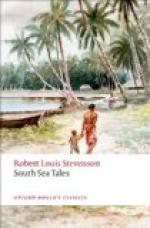The Paumotuan is sincerely attached to those of his own blood and household. A touching affection sometimes unites wife and husband. Their children, while they are alive, completely rule them; after they are dead, their bones or their mummies are often jealously preserved and carried from atoll to atoll in the wanderings of the family. I was told there were many houses in Fakarava with the mummy of a child locked in a sea-chest; after I heard it, I would glance a little jealously at those by my own bed; in that cupboard, also, it was possible there was a tiny skeleton.
The race seems in a fair way to survive. From fifteen islands, whose rolls I had occasion to consult, I found a proportion of 59 births to 47 deaths for 1887. Dropping three out of the fifteen, there remained for the other twelve the comfortable ratio of 50 births to 32 deaths. Long habits of hardship and activity doubtless explain the contrast with Marquesan figures. But the Paumotuan displays, besides, a certain concern for health and the rudiments of a sanitary discipline. Public talk with these free-spoken people plays the part of the Contagious Diseases Act; in-comers to fresh islands anxiously inquire if all be well; and syphilis, when contracted, is successfully treated with indigenous herbs. Like their neighbours of Tahiti, from whom they have perhaps imbibed the error, they regard leprosy with comparative indifference, elephantiasis with disproportionate fear. But, unlike indeed to the Tahitian, their alarm puts on the guise of self-defence. Any one stricken with this painful and ugly malady is confined to the ends of villages, denied the use of paths and highways, and condemned to transport himself between his house and coco-patch by water only, his very footprint being held infectious. Fe’efe’e, being a creature of marshes and the sequel of malarial fever, is not original in atolls. On the single isle of Makatea, where the lagoon is now a marsh, the disease has made a home. Many suffer; they are excluded (if Mr. Wilmot be right) from much of the comfort of society; and it is believed they take a secret vengeance. The defections of the sick




